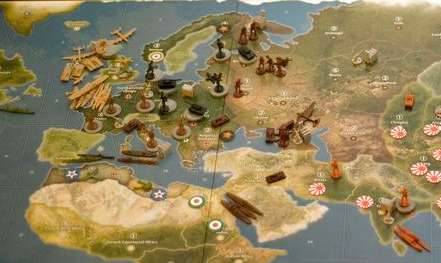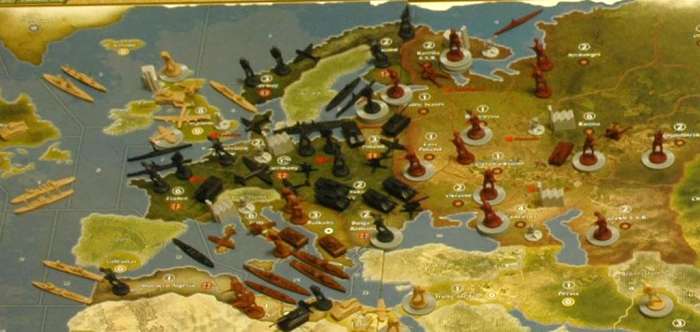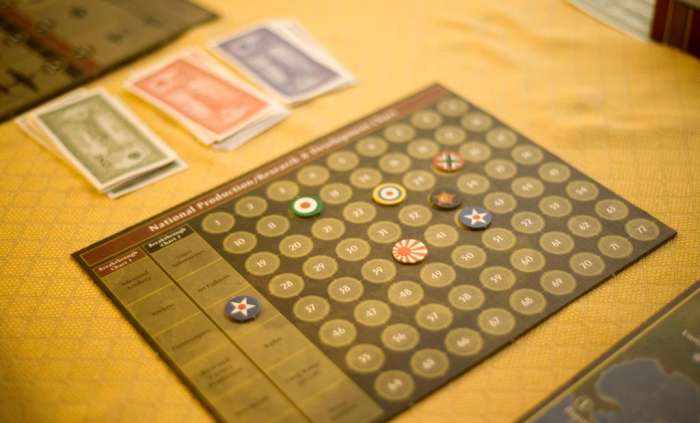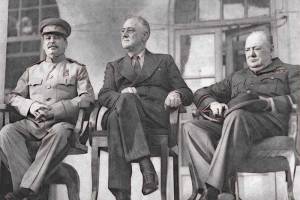We had a full living room for the
second Axis match. Sam spearheaded the evil effort with Germany, Curt took Japan, and Kristi helmed the Italian forces.
Connie reprised her command of the UK,
Rob played the Yanks, and I handled the Russian retreats.
The map above will link to a 1024-wide image (flickr max), or you can view the
left,
middle, and
right portions for more detail.
Why is there a bomber on Brazil, you might ask? Well
Curt sent an otherwise-doomed transport into the south Atlantic but it was chased down by an American bomber.
Germany opened with an
amphibious assault on Karelia - Russia's northern factory. It fell without much trouble, but was retaken by Russia's counter. The German subs and Norwegian fighter sunk the British battleship, but the air support provided for the seaborne invasion meant the destroyer in the north sea and ships near Gibraltar could escape to Iceland. The significance here was that
Germany was left with no naval assets and could not repeat with flanking assaults by boat.
The eastern front was attacked as usual and did not suffer from the diverted air support. The following turns, up to the midnight recess, saw the
buffer territories exchanged again and again. Russia concentrated on infantry but built enough tanks to blitz and counterattack. There were a few highly
desirable targets that consisted of tanks and planes with relatively few infantry, choosing these battles may have had an economic impact in the long run.
Russia did not clash with Japan but the latest board capture shows an impending battle. The Soviets did seize the opportunity to blitz into Trans-Jordan when the Italian fleet had moved to the Indian Ocean to support an amphibious invasion of Africa. The successful offensive
closed the Suez Canal and allowed a very small fleet to secure the Mediterranean for an American landing.
Her majesty's navy started turn one with a retreat to the safe waters surrounding Iceland. This was to escape the Luftwaffe and support the
predetermined turn two invasion of Norway. This amphibious strike was a point of contention among the allied commanders, as
France was then defended by a single infantry unit. There was no hope of keeping France as Germany was then producing well over 40 ipc per turn, but it would serve to draw forces away from the ugly eastern front.
The British went ahead and
took Norway to keep the eventual d-day force out of fighter range. This may have been unnecessary as the Germans could not land troops in Norway and a stack of fighters would make an easy target. Nonetheless, it
succeeded in clearing Scandinavia combined with a Russian advance on Finland.
London provided a second valuable landing in Europe. The Brits took advantage of a lightly defended Poland to
land a few units and thicken the Russian buffer. On their following turn, the UK navy sent troops to Northwestern Europe and thereby
forced Germany to commit forces westward. This amounted to about ten units at the height of Germany's productivity and likely saved the eastern front.
The US had limited engagement in Europe, but after significant coaxing did move units into an undefended north Africa.
The initial Japanese move seized much of the GSACS (greater southeast Asia co-prosperity sphere) and
secured most national objectives. The US fleets off north and south America were left intact and regrouped on the first Yank turn. The Japanese offensive included an
early capture of Australia that went a long way to depriving the British of funds.
China slowly collapsed as the Japanese forces advanced for Moscow, though the front fell short on land units.
The lack of Japanese reinforcement in China and the GSACS can be attributed to
a pair of epic sea battles with the Pacific-minded Americans. The first was an
aircraft-heavy attack on US surface warships and transports at Iwo Jima that devastated the invasion force but left quite a few untouched submarines that could not be attacked without a destroyer present.
The
subsequent American turn completed the mutual destruction by sending its sub fleet to down the carriers and support ships moved nearby to receive fighters. The remaining Yankee sub made a reckless assault on a destroyer and transport off the Japanese home island and won out on fine rolling. This allowed an undefended transport to make a suicide landing on the Philippines and recover some national objectives. But
the Pacific is very quiet.
Where does this leave us? Well Germany took the liberty of completing a turn at the end of the evening, passing the dice to...
Russia - A bit thin on units, the Soviets have to
ensure Germany doesn't take and keep Karelia, on which only two units may be placed per turn. The Russians have 50 ipc, almost twenty more than any other turn, so keeping the victory cities secure shouldn't be much trouble. The difficulty lies in how many tanks Germany has on the board and two targets in the east. Japan's mammoth production means
the Indian factory must be taken as soon as possible, however the tank in Chinghai cannot be allowed to blitz through the Motherland.
Japan -
Cash is no problem for the Japanese, but using it is. There is no bridge from the home island to Asia and the Pacific fleet is in a bad way. The greatest hope lies in
maintaining India long enough to build a few units and make a difference on the continent. The Americans are far away from the GSACS, even farther from China, so there is time to turn enormous production into domination.
UK - The Brits have a reason to smile, the
Atlantic is safe thanks to the Suez lockout and the number of German fighters sacrificed to offensive action. Also the raiding bomber that rolled a six, four turns in a row was finally downed by aa fire. There are American fighters set to reinforce any European beachhead before Germany's counter and there are
five excellent targets for landing. All that's left is for the US to liberate some GSACS territories to recover some production.
Italy - Things were going great for Italy until the Suez closed and the attempted retake of Trans-Jordan failed. A battleship and a cruiser is a formidable force, but once-great
production is now gimped back to twelve.
US - The US has maintained the initiative in the Pacific for several turns, it
finally has numbers. The key to converting its fleet and infantry into captured territories rests in the
organized deployment of invasion waves so convoys aren't picked off by Japanese fighters.
Some posts from this site with similar content.
(and some select mainstream web). I haven't personally looked at them or checked them for quality, decency, or sanity. None of these links are promoted, sponsored, or affiliated with this site. For more information, see
.














Comments